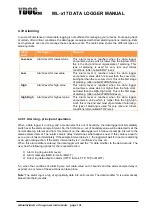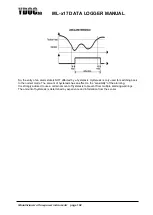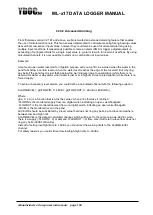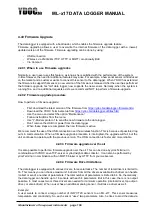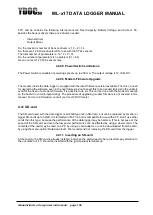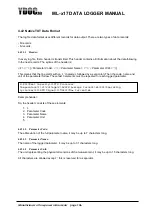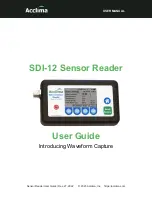
ML-x17 DATA LOGGER MANUAL
Manufacturers of low power instruments
page 97
4.35 Analog Inputs (0/4..20mA)
The ML-x17AD or ML-x17ADS is provided two analog 12 bits AD-Conversion current loop inputs. The
input signal must be a 0/4..20 mA current loop. The impedance of the system is 150 ohms. You can add
additional 0/4..20mA inputs to any ML-x17 by means of an ML-OI-AD-20MA option board.
4.35.1 Loop Powered Devices
Some devices don’t need a power supply, but take their power from the current loop. But the primary
circuit of the data logger does NOT provide power for this. In this case, you need the power switch to
provide the energy for the current-loop. Consult the manual of the loop-powered device you like to
connect, and use the positive side of the power switch for the power supply. In most cases the data
logger is connected to a device with an active output signal, so there will be no problems connecting it. If
you have questions about interfacing your device with our data logger, contact your YDOC-dealer.
4.35.2 Analog Inputs (0 .. 10 V)
The ML-x17AD or ML-x17ADS is provided two analog 12 bits AD-Conversion voltage inputs. The input
signal must be a dc signal which must not exceed 10 Volts. The user can adopt a higher voltage level if
he uses external resistors. This is done by a simple voltage divider. However this possibility offers a
flexible way to expand the range of the instrument, this is NOT covered in this manual, and the user may
not seek for support from YDOC on this topic. You can add additional 0..10V inputs to any ML-x17 by
means of an ML-OI-AD-10V option board.
4.36 Analog Differential Inputs
An ML-x17 is not provided with differential voltage inputs, but can be added by means of an ML-OI-AD-
80MV or ML-OI-AD-2000MV option board.
These inputs are very sensitive and particularly suitable for measuring signals from load cells or
pyranometers.
4.36.1 Differential input ports theory of operation
Differential inputs are very convenient for measuring differential or floating signals. The performance of a
differential input is much better than a normal, single ended one, especially with small mV signals.
Therefore, the differential inputs are very suitable for measuring load cells, pyranometers and other low-
level mV output sensors. A differential input consists of a negative (-) and a positive (+) input. The voltage
difference between these two inputs is the signal to be measured.
4.36.2 Common mode noise rejection
One of the major advantages over a single end
ed input is the common mode noise rejection. It “removes”
practically all noise that is present on the input signal. Especially with long cables, noise is always present



















